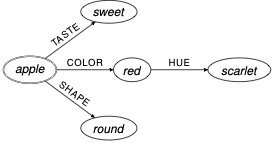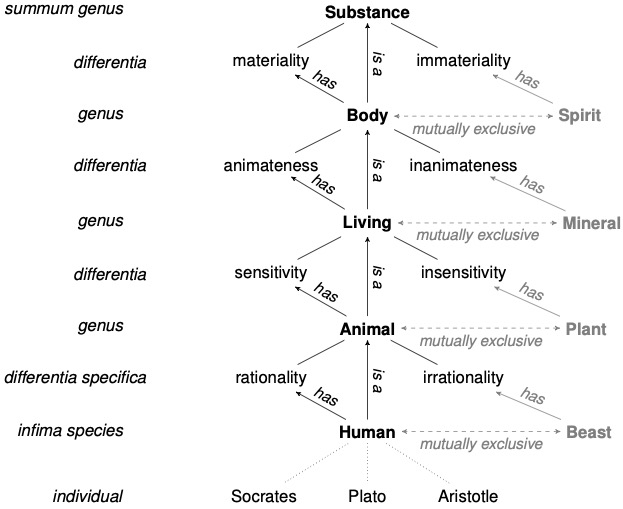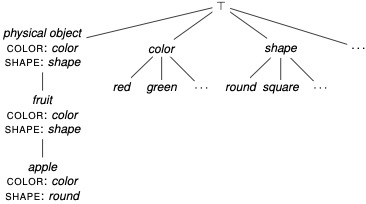The project
Originally introduced by Marvin Minsky to describe data structures in the field of artificial intelligence, the notion of frame was developed into a model of mental representation by cognitive psychologist Lawrence Barsalou in the 1990s and was soon taken up in linguistics and philosophy of science. The unified format that frame theory posits as the structure of representations in language, cognition, and science is that of an attribute-value structure. Attributes are generic feature dimensions of an object, event, or category that are specified by certain values – which in turn may be assigned further attributes. For example, a concrete apple may be assigned the attribute COLOR with the value red, and this value in turn may be assigned the attribute SHADE, say with the more specific value scarlet. Such recursive attribute-value structures, according to frame theory, underlie not only our cognitive grasp of objects, but provide the appropriate reconstruction of all our linguistic representations and even complex scientific theories.
A unified format of cognitive, linguistic, and scientific representation
While the specific notion that frame theory has of the organization of conceptual and linguistic information seems to originate in recent technological and scientific developments, it can actually be traced through more than 2000 years of philosophical history. In all epochs, approaches can be found that share essential intentions and assumptions with frame theory – all the way back to Aristotelian category theory, probably the earliest systematic differentiation model of our cognitive relation to the world. Parallels to the frame model can also be found in various conceptions of schema (Whitehead, Rumelhart) or the concept of paradigm in the philosophy of science (Kuhn). And not only category systems (Aristotle, Kant), but also memory theories (Augustine, Locke) share basic assumptions with frame theory. The DFG research project, which will run until 2024 and is based on preliminary work within the CRC 991, will investigate these continuities by means of a historical-systematic contextualization and will thus at the same time make frame theory and essential insights of its historical predecessors fruitful for modern research perspectives and applications.
A particular focus here is on the so-called type signature, which reflects the super- and subordination relations of types of frames in a hierarchical structure. In the context of frame theory, the type signature represents our world knowledge, which determines, among other things, which attributes and values are even eligible for such different things as apples or theories. For example, the type signature contains the information that the frame apple is not a frame of the type color, but of the type physical object, but that the attribute COLOR is assigned to it and that this can only assume certain values (red, green). Obviously, we are dealing here with an attempt of reconstruction of classifications and inference relations, with which philosophy has been concerned since time immemorial. The notion of a division of the objects of our thought into different basic types is already found in Aristotle's theory of categories, which also provides the basis for the reconstruction of category errors (Ryle). As Aristotle argues, exclusively members of certain categories can not only be meaningfully assigned certain properties, but also denied them. For example, it would be absurd to say of an apple rather than a theory that it is (not) explanatory – an observation that frame theory integrates into the type signature and its assignment of attributes to types of frames. In the meantime, the phenomenon of category error has been attempted to be reconstructed more precisely in many ways (such as in Sommers's neo-Aristotelian conceptual logic). Philosophically interesting and controversial about such phenomena of inadmissible attributions, well known to everyday understanding, has at all times been the question of what conclusions we can draw from the categories of our thinking about the actual nature of things in the world. The project explores both the relations between different attempts to reconstruct our cognitive and linguistic categorizations and these metaphysical and ultimately metaphilosophical questions.
From the structures of thought to the structures of the world
Central in this sense is the question of the "ontological commitments" of a certain form of representation: what must the basic structures of reality be like if we can represent them in certain attribute-value pairs that can be categorized according to different types? What reason is there to assume that these implicitly conceived structures correspond to such structures in reality? Whether from the visualization of thinkable attributions and categorizations the step to assumptions about the division of the objects of our thinking into something like naturally given "types" is indeed possible, or whether our conventions of thought and language are not subject to any constraints of a thought-independent reality and accordingly no insights about the nature of things can be gained from their analysis, is a controversial question that concerns the methods and epistemic limits of the discipline of philosophy itself. Against this background, the project aims not only to elucidate the ontological commitments of type-signature, but also to critically examine its place in traditional philosophical undertakings in which the step is made from the analysis of cognitive and linguistic assumptions to those about natural categories.




